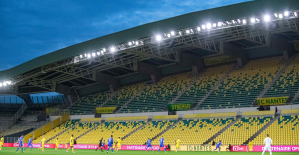The Bavarian nature conservation Fund is practically only known in the art world, he seems to be in the Background. However, funding for local projects ensures that it buzzes in Bavaria again in many places and is buzzing and blooming.
Christian SebaldPicturesque juniper heaths, flowers, sage-filled meadows, steep Grasslands, bizarre rocks, gurgling streams: The Franconian Jura near Bamberg is the most time of the year is a colourful landscape, it buzzes and hums. That you stand so gorgeous, has a lot to do with the commitment of the population, the nature protection associations and all sorts of authorities. But especially with the Bavarian nature conservation Fund. The state Foundation has invested in over the years 330 000 Euro in nature conservation projects in the Region.
The money has primarily gone into the sheepfold. Because for centuries, meadows, shepherds with their flocks, the juniper, Sage and Grassland kept short and for the unique variety of Flora and Fauna in the Jura. With the extinction of the Transhumance pastures were in danger of messing with the verb and overgrown. Almost as special plants such as the bee Orchid or the fringed gentian, but also of the wart-biter and other rare locusts had completely disappeared from the law.
When it comes to conservation, everyone thinks immediately of the Bund Naturschutz (BN) or the national Federation for the protection of birds (LBV), with Thousands of volunteers. Also, the landscape management associations play an important role in the free state. And of course, local authorities will make again and again to the biotopes on your hallways deserve. The Bavarian nature conservation Fund, however, is practically only known in the art. This is due to the fact that he seems to be in the Background.
Two fritillary - the kind of vulnerable, and correspondingly rare.
(photo: LPV Bamberg/oh)Where could associations, the nature conservation and the municipalities without the state's Foundation, not so successfully put to use for Flora and Fauna. Because of a lot of money for their projects. "The conservation Fund is a key pillar when it comes to biological diversity," says Minister for the environment, Thorsten Glauber (Free voters), is the ex-officio Chairman of the Foundation Council. "Thanks to funding great projects, such as the can be in the Franconian Jura to the conservation of our diverse natural and home."
The conservation Fund is one of the oldest state nature protection foundations in Germany. It was established in 1982. The Foundation's purpose is solely the promotion of nature conservation projects. Does the Fund mainly from the fact that he supports associations and municipalities in the Lease or purchase of "land for purposes of nature conservation and landscape care", as stated in article 50 of the Bavarian nature conservation act, which regulates the Fund. The eight employees of the Foundation and Foundation Board of Directors Georg Limp also advise associations and municipalities in the design of projects, in research and in educational work. Limp, 62, diploma biologist, has in his profession in all areas of nature conservation management the life go through. Since 2007, he is at the top of the Foundation.
Six to seven million euros, the nature reserve Fund in the year. A stem of up to 1.5 million from the proceeds of the Foundation capital of 18.5 million euros. Add to this a quarter of the revenue of the welfare lottery, wheel of fortune in Bavaria. They make up 2.5 to three million per year. The free state shall pay a further 2.5 million in the year. "All in all, up to seven million euros per year to come together," said Limp, "After deducting personnel and material costs, as is the case of foundations, usual, we can pay 5.5 to six million euros a year to projects."
Georg Limp since 2007 Foundation Board of Directors.
(photo: StmUV)And to small as to large. "A classic example of a small project, an Orchid meadow or a piece of forest with old trees, wants to buy a circle group of the TCAS or the BN, in order to receive it as a biotope," says Limp. "Then the circle group of a grant application to the Fund. The project adopted fits, and the area is 35 000 euros, then we assume 30 000 Euro. 5000 euros has to pay for the circle group."
This is one of the fundamental rules of the nature reserve Fund. He financed a project is never complete. But calls for getting a share of the respective carrier. "Alone, because such an equity share is a certain guarantee that the candidate really means it," says Limp. The equity share is 15 to 25 percent of the project volume. All in all, the Foundation supports about 50 small projects in a year.
Large projects gobble up a several hundred thousand Euro. The protection of the greater Horseshoe bats in the high castle. The species of bat is extinct in Germany. A colony only in the upper Palatinate location. Thus, the Art has a future, has established the TCAS protection areas set up, bat towers erected on the place close to the troops exercise a ruin as a bat accommodation arranged and even a research institution, and is bat-weeks tube. All of that has been more than swallowed up a Million Euro. The conservation Fund has almost 400 000 euros. The reward: The number of Horseshoe bats in the high castle has more than doubled, the colony is stable.
The Fund is a "supporting pillar" when it comes to biological diversity: the meadow of Flowers with Amstling in the Franconian Jura.
(photo: LPV Bamberg/oh)"are The major projects of our lighthouses," says Limp. "You show that you can move forward in nature conservation when it is clamped right behind it and ready to invest money." Especially in the case of the large projects, never only the a type, which is officially in the foreground. But the appreciation of entire regions. In the high castle, for example, you have set a lot of tables, Hiking trails created and an info centre set up. The conservation Fund supported about 20 such large-scale projects in the year.
The ambition of Limp and his co-workers, your projects, if possible, to the whole of Bavaria radiate. As the latest, the start of 2019 in the Rhön. There, the BN and one company of the farmers Association and the local machinery ring with Biogas farmers will be testing on up to a hundred hectares of arable land for new energy crops. "Instead of Corn, the moderation has recognized in a loud disadvantages for the native Flora and Fauna, to sow the Veitshöchheimer hemp Mix," says Limp. "This is a Blühmischung with Wild carrot, safflower, tansy, mullein and many other, mostly native plants with lots of biomass."
is the expectation of The conservationists, that the hemp Mix of the insect and bird world is doing in the Region. "We have evidence that in a Blühacker up to 60 wild bees-all sorts of fish and birds such as the Whitethroat and the Schafstelz," says Limp. "In a Maize field, however, a gaping Void prevails." Of course, such a Blühacker is less profitable than a corn field. Therefore, the farmers who participate will get 500 euros of aid per hectare and year. "To confirm our expectations and the project can be transferred to other areas," says Slack, "then the 300 000 Euro, which we have planned for this, really money well spent for the nature."

 Iran-Israel conflict: what we know about the events of the night after the explosions in Isfahan
Iran-Israel conflict: what we know about the events of the night after the explosions in Isfahan Sydney: Assyrian bishop stabbed, conservative TikToker outspoken on Islam
Sydney: Assyrian bishop stabbed, conservative TikToker outspoken on Islam Torrential rains in Dubai: “The event is so intense that we cannot find analogues in our databases”
Torrential rains in Dubai: “The event is so intense that we cannot find analogues in our databases” Rishi Sunak wants a tobacco-free UK
Rishi Sunak wants a tobacco-free UK Alert on the return of whooping cough, a dangerous respiratory infection for babies
Alert on the return of whooping cough, a dangerous respiratory infection for babies Can relaxation, sophrology and meditation help with insomnia?
Can relaxation, sophrology and meditation help with insomnia? WHO concerned about spread of H5N1 avian flu to new species, including humans
WHO concerned about spread of H5N1 avian flu to new species, including humans New generation mosquito nets prove much more effective against malaria
New generation mosquito nets prove much more effective against malaria The A13 motorway closed in both directions for an “indefinite period” between Paris and Normandy
The A13 motorway closed in both directions for an “indefinite period” between Paris and Normandy The commitment to reduce taxes of 2 billion euros for households “will be kept”, assures Gabriel Attal
The commitment to reduce taxes of 2 billion euros for households “will be kept”, assures Gabriel Attal Unemployment insurance: Gabriel Attal leans more towards a tightening of affiliation conditions
Unemployment insurance: Gabriel Attal leans more towards a tightening of affiliation conditions “Shrinkflation”: soon posters on shelves to alert consumers
“Shrinkflation”: soon posters on shelves to alert consumers The restored first part of Abel Gance's Napoléon presented at Cannes Classics
The restored first part of Abel Gance's Napoléon presented at Cannes Classics Sting and Deep Purple once again on the bill at the next Montreux Jazz Festival
Sting and Deep Purple once again on the bill at the next Montreux Jazz Festival Rachida Dati: one hundred days of Culture on the credo of anti-elitism
Rachida Dati: one hundred days of Culture on the credo of anti-elitism The unbearable wait for Marlène Schiappa’s next masterpiece
The unbearable wait for Marlène Schiappa’s next masterpiece Skoda Kodiaq 2024: a 'beast' plug-in hybrid SUV
Skoda Kodiaq 2024: a 'beast' plug-in hybrid SUV Tesla launches a new Model Y with 600 km of autonomy at a "more accessible price"
Tesla launches a new Model Y with 600 km of autonomy at a "more accessible price" The 10 best-selling cars in March 2024 in Spain: sales fall due to Easter
The 10 best-selling cars in March 2024 in Spain: sales fall due to Easter A private jet company buys more than 100 flying cars
A private jet company buys more than 100 flying cars This is how housing prices have changed in Spain in the last decade
This is how housing prices have changed in Spain in the last decade The home mortgage firm drops 10% in January and interest soars to 3.46%
The home mortgage firm drops 10% in January and interest soars to 3.46% The jewel of the Rocío de Nagüeles urbanization: a dream villa in Marbella
The jewel of the Rocío de Nagüeles urbanization: a dream villa in Marbella Rental prices grow by 7.3% in February: where does it go up and where does it go down?
Rental prices grow by 7.3% in February: where does it go up and where does it go down? With the promise of a “real burst of authority”, Gabriel Attal provokes the ire of the opposition
With the promise of a “real burst of authority”, Gabriel Attal provokes the ire of the opposition Europeans: the schedule of debates to follow between now and June 9
Europeans: the schedule of debates to follow between now and June 9 Europeans: “In France, there is a left and there is a right,” assures Bellamy
Europeans: “In France, there is a left and there is a right,” assures Bellamy During the night of the economy, the right points out the budgetary flaws of the macronie
During the night of the economy, the right points out the budgetary flaws of the macronie These French cities that will boycott the World Cup in Qatar
These French cities that will boycott the World Cup in Qatar Champions League: France out of the race for 5th qualifying place
Champions League: France out of the race for 5th qualifying place Ligue 1: at what time and on which channel to watch Nantes-Rennes?
Ligue 1: at what time and on which channel to watch Nantes-Rennes? Marseille-Benfica: 2.99 million viewers watching OM’s victory on M6
Marseille-Benfica: 2.99 million viewers watching OM’s victory on M6 Cycling: Cofidis continues its professional adventure until 2028
Cycling: Cofidis continues its professional adventure until 2028


















